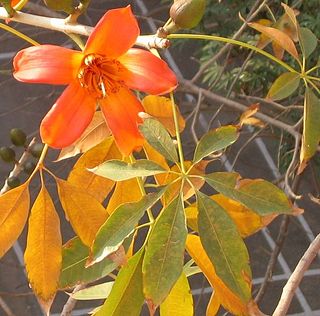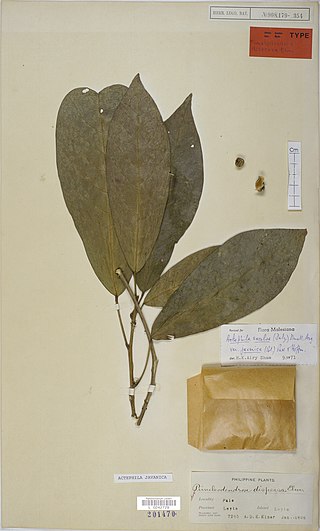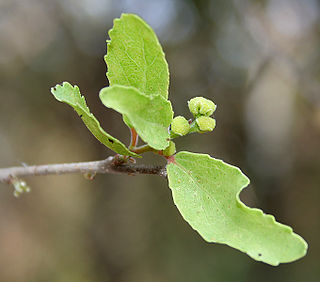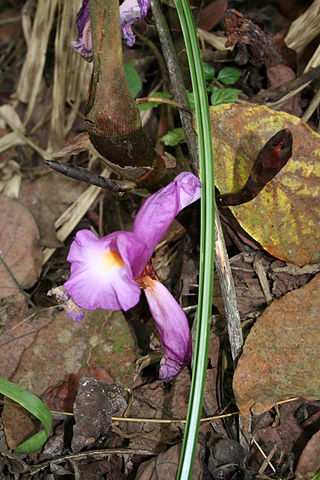
François Gagnepain was a French botanist. The standard botanical author abbreviation Gagnep. is applied to plants described by Gagnepain.

Antidesma is a genus of tropical plant in the family Phyllanthaceae formally described by Linnaeus in 1753. It is native to tropical Africa, S + E + SE Asia, Australia, and various oceanic islands. The greatest diversity occurs in Southeast Asia.

Bombax is a genus of mainly tropical trees in the mallow family. They are native to western Africa, the Indian subcontinent, Southeast Asia, and the subtropical regions of East Asia and northern Australia. It is distinguished from the genus Ceiba, which has whiter flowers.

Terminalia is a genus of large trees of the flowering plant family Combretaceae, comprising nearly 300 species distributed in tropical regions of the world. The genus name derives from the Latin word terminus, referring to the fact that the leaves appear at the very tips of the shoots.

Typhonium is a genus in the family Araceae native to eastern and southern Asia, New Guinea, and Australia. It is most often found growing in wooded areas.
- Typhonium acetosellaGagnep. - Cambodia, Laos, Thailand, Vietnam
- Typhonium adnatumHett. & Sookch. - Thailand
- Typhonium albidinerviumC.Z.Tang & H.Li - Guangdong, Hainan, Laos, Thailand
- Typhonium albispathumBogner - Thailand
- Typhonium alismifoliumF.Muell. - Queensland, Northern Territory
- Typhonium angustilobumF.Muell. - Queensland, New Guinea
- Typhonium bachmaenseV.D.Nguyen & Hett. - Vietnam
- Typhonium baoshanenseZ.L.Dao & H.Li - Yunnan
- Typhonium blumeiNicolson & Sivad. - Japan, Taiwan, Ryukyu Islands, much of China, Bangladesh, Laos, Cambodia, Myanmar, Thailand, Vietnam; naturalized in Madagascar, Mauritius, Comoros, Borneo, Philippines, West Indies
- Typhonium bognerianumJ.Murata & Sookch. - Thailand
- Typhonium browniiSchott - Queensland, New South Wales
- Typhonium bulbiferumDalzell - southern India
- Typhonium circinnatumHett. & J.Mood - Vietnam
- Typhonium cochleareA.Hay - Northern Territory of Australia
- Typhonium cordifoliumS.Y.Hu - Thailand
- Typhonium digitatumHett. & Sookch. - Thailand
- Typhonium echinulatumHett. & Sookch. - Thailand
- Typhonium eliosurum(F.Muell. ex Benth.) O.D.Evans - New South Wales
- Typhonium filiformeRidl. - Thailand, Malaysia
- Typhonium flagelliforme(G.Lodd.) Blume - Guangdong, Guangxi, Yunnan, Bangladesh, Bhutan, Cambodia, India, Indonesia, Laos, Malaysia, Myanmar, Philippines, Singapore, Sri Lanka, Thailand, New Guinea, Queensland, Northern Territory
- Typhonium fultumRidl. - Thailand, Malaysia
- Typhonium gagnepainiiJ.Murata & Sookch. - Thailand, Cambodia
- Typhonium gallowayiHett. & Sookch. - Thailand
- Typhonium glaucumHett. & Sookch. - Thailand
- Typhonium griseumHett. & Sookch. - Thailand
- Typhonium hayataeSriboonma & J.Murata - Vietnam
- Typhonium huenseNguyen & Croat - Vietnam
- Typhonium hunanenseH.Li & Z.Q.Liu - Hunan
- Typhonium inopinatumPrain - India, Myanmar, Thailand
- Typhonium jinpingenseZ.L.Wang, H.Li & F.H.Bian - Yunnan
- Typhonium johnsonianumA.Hay & S.M.Taylor - Northern Territory of Australia
- Typhonium jonesiiA.Hay - Northern Territory of Australia
- Typhonium laoticumGagnep. - Thailand, Laos
- Typhonium liliifoliumF.Muell. ex Schott - Northern Territory, Western Australia
- Typhonium lineareHett. & V.D.Nguyen - Vietnam
- Typhonium listeriPrain - Assam, Bangladesh, Myanmar
- Typhonium medusaeHett. & Sookch. - Thailand
- Typhonium mirabile(A.Hay) A.Hay - Melville Island of Australia
- Typhonium neogracileJ.Murata - Assam, Bangladesh, Myanmar
- Typhonium nudibaccatumA.Hay - Western Australia
- Typhonium orbifoliumHett. & Sookch. - Thailand
- Typhonium pedatisectumGage - Myanmar
- Typhonium pedunculatumHett. & Sookch. - Thailand
- Typhonium peltandroidesA.Hay, M.D.Barrett & R.L.Barrett - Western Australia
- Typhonium penicillatumV.D.Nguyen & Hett. - Vietnam
- Typhonium pottingeriPrain - Myanmar
- Typhonium praecoxJ.Murata - Myanmar
- Typhonium praetermissumA.Hay - Northern Territory of Australia
- Typhonium pusillumSookch., V.D.Nguyen & Hett. - Thailand
- Typhonium reflexumHett. & Sookch. - Thailand
- Typhonium roxburghiiSchott - Taiwan, Yunnan, Bonin Islands, India, Bangladesh, Sri Lanka, Andaman Islands, Thailand, Malaysia, western Indonesia, Philippines, New Guinea; naturalized in Western Australia, eastern Brazil, Tanzania
- Typhonium russell-smithiiA.Hay - Northern Territory of Australia
- Typhonium sagittariifoliumGagnep. - Thailand
- Typhonium saraburiensisSookch., Hett. & J.Murata - Thailand
- Typhonium sinhabaedyaeHett. & A.Galloway - Thailand
- Typhonium smitinandiiSookch. & J.Murata - Thailand
- Typhonium stigmatilobatumV.D.Nguyen - Vietnam
- Typhonium subglobosumHett. & Sookch. - Thailand
- Typhonium tayloriiA.Hay - Northern Territory of Australia
- Typhonium trifoliatumF.T.Wang & H.S.Lo ex H.Li, Y.Shiao & S.L.Tseng - Mongolia, Hebei, Inner Mongolia, Shaanxi, Shanxi
- Typhonium trilobatum(L.) Schott - southern China, Indian Subcontinent, Indochina; naturalized in Windward Islands, Ivory Coast, Borneo, Philippines
- Typhonium tubispathumHett. & A.Galloway - Thailand
- Typhonium variansHett. & Sookch. - Thailand
- Typhonium vermiformeV.D.Nguyen & Croat - Vietnam
- Typhonium violifoliumGagnep. - Myanmar, Thailand
- Typhonium watanabeiJ.Murata, Sookch. & Hett. - Thailand
- Typhonium weipanumA.Hay - Queensland
- Typhonium wilbertiiA.Hay - Queensland

Actephila is a genus of plants in the family Phyllanthaceae, first described as a genus in 1826. It is one of 8 genera in the tribe Poranthereae, and is most closely related to Leptopus. The name of the genus is derived from two Greek words, akte, "the seashore", and philos, "loving". It refers to a coastal habitat.

Tetrastigma is a genus of plants in the grape family, Vitaceae. The plants are lianas that climb with tendrils and have palmately compound leaves. Plants are dioecious, with separate male and female plants; female flowers are characterized by their four-lobed stigmas. The species are found in subtropical and tropical regions of Asia, Malaysia, and Australia, where they grow in primary rainforest, gallery forest and monsoon forest and moister woodland. Species of this genus are notable as being the sole hosts of parasitic plants in the family Rafflesiaceae, one of which, Rafflesia arnoldii, produces the largest single flower in the world. Tetrastigma is the donor species for horizontal gene transfer to Sapria and Rafflesia due to multiple gene theft events.

Laportea is a genus of plants in the family Urticaceae. They are herbaceous, either annual or perennial. Like many plants of the Urticaceae, they have stinging hairs. There are stinging and non-stinging hairs on the same plant. The genus was named after the French naturalist Francis de Laporte de Castelnau.

Entada is a genus of flowering plants in the family Fabaceae, in the mimosoid clade of the subfamily Caesalpinioideae. It consists of some 30 species of trees, shrubs and tropical lianas. About 21 species are known from Africa, six from Asia, two from the American tropics and one with a pantropical distribution. They have compound leaves and produce exceptionally large seedpods of up to 1.5 metres (4.9 ft) long. Their seeds are buoyant and survive lengthy journeys via rivers and ocean currents, to eventually wash up on tropical beaches.

Tetracera is a genus of flowering plants of the Dilleniaceae family native to the tropics. Several species are lianas.

Dodonaeoideae is a subfamily of flowering plants in the soapberry family, Sapindaceae.

Dendrolobium is a genus of flowering plants in the legume family, Fabaceae. It belongs to the subfamily Faboideae. It includes 21 species of mostly trees and shrubs and rarely herbs. Species range from eastern Africa to Madagascar, India, Indochina, southern China, Malesia, Papuasia, northern and western Australia, and the southwestern Pacific. Typical habitats include seasonally-dry tropical forest and woodland, bamboo thickets, and grassland.

Smithia is a genus of flowering plants in the legume family, Fabaceae. It includes 20 species of herbs or subshrubs native to sub-Saharan Africa, the Indian subcontinent, Indochina, southern China, Japan, Malesia, and northern Australia. The greatest diversity of species is in the Indian subcontinent, with 11 endemic species. Six more are widespread in southern and eastern Asia, and two of these, S. conferta and S. sensitiva, range further to northern Australia. Two species are endemic to sub-Saharan Africa. S. elliotii is native to Madagascar as well as mainland Africa, and S. conferta is also native to Madagascar. Typical habitats include seasonally-dry tropical grassland, wetlands, and streamsides.

Brachycorythis is a genus of flowering plants from the orchid family, Orchidaceae. It contains approximately 40-50 species native mostly to Africa and Madagascar but also some from South and East Asia.

Flacourtia is a genus of flowering plants in the family Salicaceae. It was previously placed in the now defunct family Flacourtiaceae. The generic name honors Étienne de Flacourt (1607–1660), a governor of Madagascar. It contains 23 species of shrubs and small trees that are native to the African and Asian tropics and subtropics. Several species, especially Flacourtia indica, are cultivated as ornamentals and for their fruits. The trunks of small trees are often guarded by branching spines.

Curculigo is a flowering plant genus in the family Hypoxidaceae, first described in 1788. It is widespread across tropical regions of Asia, Africa, Australia, and the Americas.

Aframomum is a genus in the ginger family, Zingiberaceae. It is widespread across tropical Africa as well as on some islands of the Indian Ocean. It is represented by approximately 50 species. It is larger than other genera in its family. Its species are perennials and produce colorful flowers.
Aulotandra is a genus of plants native to Cameroon and Madagascar.
Pantadenia adenanthera is a shrub in the Euphorbiaceae family. It is found in parts of Southeast Asia. The species is used for its wood and edible fruit.

The Cayratieae is one of five tribes of vine plants that are now recognised in this subfamily Vitoideae. It contains genera restored or newly erected from species in the previously configured genus Cayratia, which was found not be monophyletic:.

















